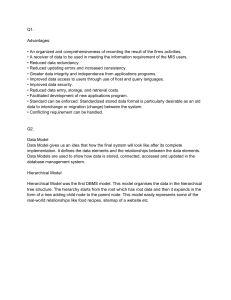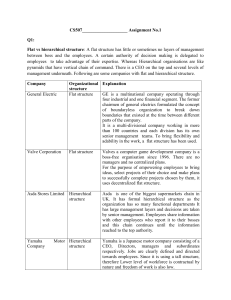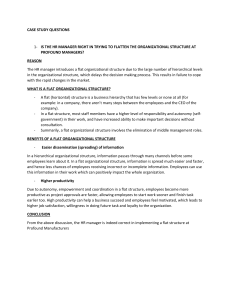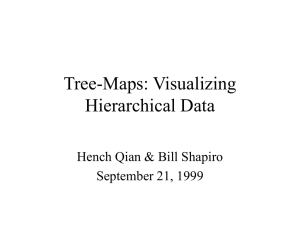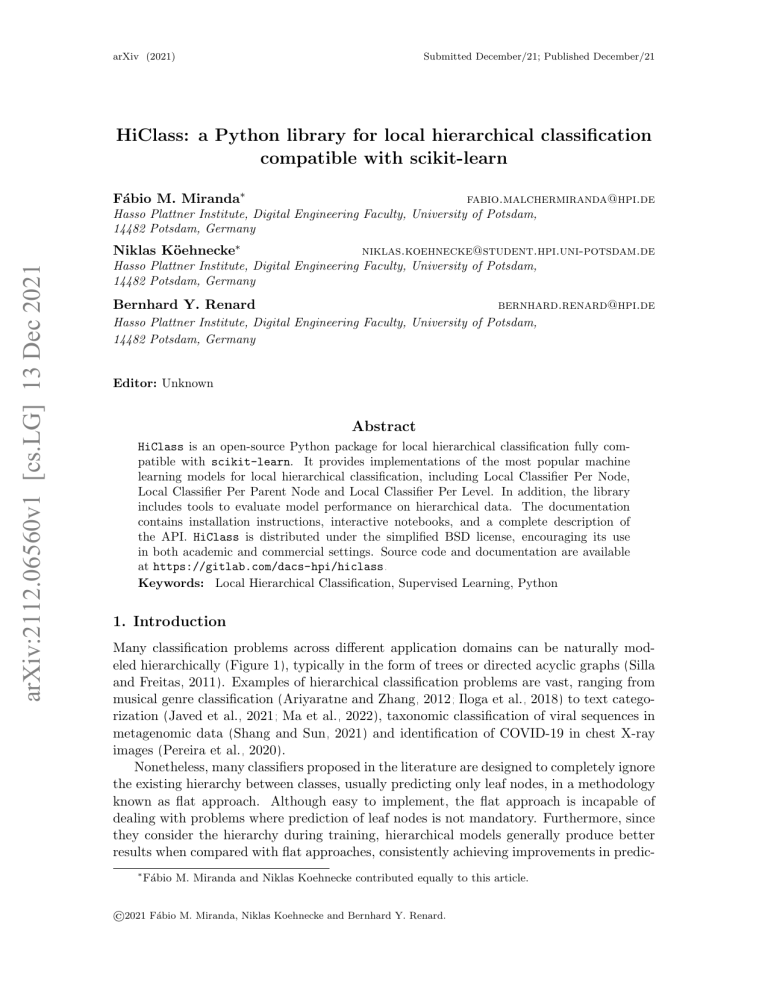
arXiv (2021)
Submitted December/21; Published December/21
HiClass: a Python library for local hierarchical classification
compatible with scikit-learn
Fábio M. Miranda∗
fabio.malchermiranda@hpi.de
Hasso Plattner Institute, Digital Engineering Faculty, University of Potsdam,
14482 Potsdam, Germany
arXiv:2112.06560v1 [cs.LG] 13 Dec 2021
Niklas Köehnecke∗
niklas.koehnecke@student.hpi.uni-potsdam.de
Hasso Plattner Institute, Digital Engineering Faculty, University of Potsdam,
14482 Potsdam, Germany
Bernhard Y. Renard
bernhard.renard@hpi.de
Hasso Plattner Institute, Digital Engineering Faculty, University of Potsdam,
14482 Potsdam, Germany
Editor: Unknown
Abstract
HiClass is an open-source Python package for local hierarchical classification fully compatible with scikit-learn. It provides implementations of the most popular machine
learning models for local hierarchical classification, including Local Classifier Per Node,
Local Classifier Per Parent Node and Local Classifier Per Level. In addition, the library
includes tools to evaluate model performance on hierarchical data. The documentation
contains installation instructions, interactive notebooks, and a complete description of
the API. HiClass is distributed under the simplified BSD license, encouraging its use
in both academic and commercial settings. Source code and documentation are available
at https://gitlab.com/dacs-hpi/hiclass.
Keywords: Local Hierarchical Classification, Supervised Learning, Python
1. Introduction
Many classification problems across different application domains can be naturally modeled hierarchically (Figure 1), typically in the form of trees or directed acyclic graphs (Silla
and Freitas, 2011). Examples of hierarchical classification problems are vast, ranging from
musical genre classification (Ariyaratne and Zhang, 2012; Iloga et al., 2018) to text categorization (Javed et al., 2021; Ma et al., 2022), taxonomic classification of viral sequences in
metagenomic data (Shang and Sun, 2021) and identification of COVID-19 in chest X-ray
images (Pereira et al., 2020).
Nonetheless, many classifiers proposed in the literature are designed to completely ignore
the existing hierarchy between classes, usually predicting only leaf nodes, in a methodology
known as flat approach. Although easy to implement, the flat approach is incapable of
dealing with problems where prediction of leaf nodes is not mandatory. Furthermore, since
they consider the hierarchy during training, hierarchical models generally produce better
results when compared with flat approaches, consistently achieving improvements in predic∗
Fábio M. Miranda and Niklas Koehnecke contributed equally to this article.
©2021 Fábio M. Miranda, Niklas Koehnecke and Bernhard Y. Renard.
Miranda, Koehnecke and Renard
tive performance (Silla and Freitas, 2011). Hence, in this manuscript we introduce HiClass,
a python library that implements the most common patterns for local hierarchical classifiers
(Figure 1), which can be employed in different application domains where the data can be
hierarchically structured in the shape of trees or directed acyclic graphs. While ideally the
full hierarchical structure is known, classification is also possible with only partially known
structures and missing values in intermediate levels of the hierarchy.
Figure 1: Depiction of the flat approach and the local hierarchical classification models
implemented in HiClass, for a two-level hierarchy. a) Flat approach, where a
single multi-class classifier is trained to predict only the leaf nodes in hierarchical
data, completely ignoring previous levels of the hierarchy. b) Local classifier per
node, where several binary classifiers are trained for each existing node in the
hierarchy, excluding the root node. c) Local classifier per parent node, where
various multi-class classifiers are trained for each parent node in the hierarchy,
with the goal of predicting the children nodes. d) Local classifier per level, where
a multi-class classifier is trained for each level in the hierarchy.
2. Overview and Design
The API of HiClass is designed to be compatible with the scikit-learn API (Pedregosa
et al., 2011), offering users a familiar API to train hierarchical models via fit(), store
2
HiClass: a Python library for local hierarchical classification compatible with scikit-learn
trained models with pickle and predict labels with the predict() method. Moreover, each
local classifier in HiClass is by default scikit-learn’s BaseEstimator class, enabling users to
employ any of the classifiers already implemented in scikit-learn’s library. However, classes
other than the BaseEstimator can also be used, as long as they implement the methods
fit(), predict() and clone(), thus enabling users to code their own local classifiers using
third-party libraries, e.g., TensorFlow (Abadi et al., 2016) or PyTorch (Paszke et al., 2019).
To allow a better integration with scikit-learn and faster training, HiClass uses for
both features and labels numpy’s structured arrays, whose data type is a composition of
simpler data types (Harris et al., 2020). While features are exactly the same shape as
expected for training flat models in scikit-learn, hierarchical training labels are represented
as an array of shape n samples × n levels, where each column must contain either a label
for the respective level in the hierarchy or a placeholder that indicates missing labels in the
hierarchical structure.
The directed acyclic graph (DAG) implemented in the library NetworkX (Hagberg et al.,
2008) was the data structure chosen to make the models as generic as possible, since hierarchical data in the form of trees can also be represented with a DAG. Training is performed
in parallel for each local classifier, while prediction, which is not a bottleneck, is performed
from top to bottom, following the hierarchical structure to keep consistency among the
several hierarchical levels.
According to Silla and Freitas (2011), the use of flat classification metrics might not be
adequate to give enough insight of which algorithm is better at classifying hierarchical data.
Hence, in HiClass we implemented the metrics of hierarchical precision (hP), hierarchical
recall (hR) and hierarchical f-score (hF), which are extensions of the renowned metrics of
precision, recall and f-score, but tailored to the hierarchical classification scenario. These hierarchical counterparts were initially proposed by Kiritchenko et al. (2006), and are defined
as follows:
P
P
|αi ∩ βi |
2 × hP × hR
iP
i |αi ∩ βi |
hP =
, hR = P
, hF =
hP + hR
i |αi |
i |βi |
where αi is the set consisting of the most specific classes predicted for test example i and
all their ancestor classes, while βi is the set containing the true most specific classes of test
example i and all their ancestors, with summations computed over all test examples.
3. Code Quality Assurance
To ensure high code quality, inheritance is applied whenever possible to keep the code
concise and easier to maintain, and all implementations adhere to the PEP 8 code style
(Van Rossum et al., 2001) enforced by flake8 and the uncompromising code formatter
black. Documentation is provided through docstrings (Goodger and van Rossum, 2010),
and the implementations are accompanied by unit tests that cover 99% of our code and
are automatically executed by our continuous integration workflow upon commits.
3
Miranda, Koehnecke and Renard
4. Installation and Usage
HiClass is hosted on GitLab1 , interactive tutorials in the form of notebooks are available on
the platform Google Colab2 and API documentation is hosted on Read the Docs3 . Packages for Python 3.8.3 and above are available for Linux, macOS and Windows and can be
obtained with pip install hiclass or conda install -c conda-forge hiclass. Algorithm 1 shows a basic example of fitting and evaluating a local hierarchical model with
HiClass. More elaborate examples can be found in the interactive tutorials.
1
2
3
from hiclass . metrics import f1
from hiclass import L oc al Cla ss if ier Pe rN ode
from sklearn . ensemble import R an do mFo re st Cla ss if ier
4
5
6
7
# Import data
X_train , X_test = get_features () # ( n_samples , n_features )
Y_train , Y_test = get_labels () # ( n_samples , n_levels )
8
9
10
11
12
13
# Use random forest classifiers for every node
rf = R an do mFo re st Cla ss if ier ()
lcpn = L oc al Cla ss if ier Pe rN ode ( local_classifier = rf )
lcpn . fit ( X_train , Y_train ) # Train hierarchical classifier
predictions = lcpn . predict ( X_test ) # Predict test data
14
15
16
# Print hierarchical f - score
print ( " f1 : %.2 f " % ( round ( f1 ( y_true = Y_test , y_pred = predictions ) , 3) ) )
Algorithm 1: Example on how to use HiClass to train and evaluate a hierarchical classifier.
5. Comparison with Flat Classifiers
While HiClass focuses on ease of use and is fully written in a high level language, care has
been taken to maximize computational efficiency. In Figure 2, we compare the hierarchical fscore and computational resources (measured with the command time) between a couple of
flat classifiers with default parameters from the library scikit-learn and the local hierarchical
classifiers implemented in HiClass, where each local classifier contains the same parameters
of the corresponding flat classifier (see Supplementary Table S1 for hierarchical precision
and recall). For comparison purposes, we used the amazon product review dataset4 , which
contains 40,000 instances for training and 10,000 more for validation. The benchmark was
computed on a cluster node running GNU/Linux with 512 GB physical memory and 128
cores provided by two AMD EPYC™ 7742 processors.
Our results reveal that the hierarchical f-score was enhanced by all local hierarchical
approaches when compared with the logistic regression flat classifier, while training time
and memory usage were greatly reduced with the local classifiers per node and per parent
node. However, when compared with the random forest flat classifier, only the local classifier
1.
2.
3.
4.
https://gitlab.com/dacs-hpi/hiclass
https://colab.research.google.com/drive/1Idzht9dNoB85pjc9gOL24t9ksrXZEA-9?usp=sharing
https://hiclass.readthedocs.io/
https://www.kaggle.com/kashnitsky/hierarchical-text-classification
4
HiClass: a Python library for local hierarchical classification compatible with scikit-learn
per node improved the hierarchical f-score, but both local classifiers per node and per parent
node still showed a considerable decline in memory consumption.
Logistic Regression
Random Forest
Figure 2: Comparison between flat approaches and local hierarchical classifiers implemented
in HiClass. For this benchmark, the metrics used were hierarchical f-score computed for the 3 different hierarchical levels in the amazon product review dataset,
time in seconds and memory usage in gigabyte. Overall, the hierarchical classifier per node improved the hierarchical f-score and reduced memory consumption
when compared with the flat approaches.
6. Conclusion
HiClass is a Python package that provides implementations of popular machine learning
models and evaluation metrics for local hierarchical classification. Thanks to its compatibility with the scikit-learn API, users can choose among existing classifiers to create powerful
hierarchical classifiers for hierarchical data.
Acknowledgments
BYR gratefully acknowledges support by the BMBF-funded Computational Life Science
initiative (project DeepPath, 031L0208, to B.Y.R.).
5
Miranda, Koehnecke and Renard
References
Martı́n Abadi, Paul Barham, Jianmin Chen, Zhifeng Chen, Andy Davis, Jeffrey Dean,
Matthieu Devin, Sanjay Ghemawat, Geoffrey Irving, Michael Isard, et al. Tensorflow:
A system for large-scale machine learning. In 12th {USENIX} symposium on operating
systems design and implementation ({OSDI} 16), pages 265–283, 2016.
Hasitha B Ariyaratne and Dengsheng Zhang. A novel automatic hierachical approach to
music genre classification. In 2012 IEEE International Conference on Multimedia and
Expo Workshops, pages 564–569. IEEE, 2012.
David Goodger and Guido van Rossum. Docstring conventions. In Pro Python, pages
303–307. Springer, 2010.
Aric Hagberg, Pieter Swart, and Daniel S Chult. Exploring network structure, dynamics,
and function using networkx. Technical report, Los Alamos National Lab.(LANL), Los
Alamos, NM (United States), 2008.
Charles R Harris, K Jarrod Millman, Stéfan J van der Walt, Ralf Gommers, Pauli Virtanen,
David Cournapeau, Eric Wieser, Julian Taylor, Sebastian Berg, Nathaniel J Smith, et al.
Array programming with numpy. Nature, 585(7825):357–362, 2020.
Sylvain Iloga, Olivier Romain, and Maurice Tchuenté. A sequential pattern mining approach
to design taxonomies for hierarchical music genre recognition. Pattern Analysis and
Applications, 21(2):363–380, 2018.
Taimoor Ahmed Javed, Waseem Shahzad, and Umair Arshad. Hierarchical text classification of urdu news using deep neural network. arXiv preprint arXiv:2107.03141, 2021.
Svetlana Kiritchenko, Stan Matwin, Richard Nock, and A Fazel Famili. Learning and
evaluation in the presence of class hierarchies: Application to text categorization. In
Conference of the Canadian Society for Computational Studies of Intelligence, pages 395–
406. Springer, 2006.
Yinglong Ma, Xiaofeng Liu, Lijiao Zhao, Yue Liang, Peng Zhang, and Beihong Jin. Hybrid
embedding-based text representation for hierarchical multi-label text classification. Expert
Systems with Applications, 187:115905, 2022.
Adam Paszke, Sam Gross, Francisco Massa, Adam Lerer, James Bradbury, Gregory Chanan,
Trevor Killeen, Zeming Lin, Natalia Gimelshein, Luca Antiga, et al. Pytorch: An imperative style, high-performance deep learning library. Advances in neural information
processing systems, 32:8026–8037, 2019.
Fabian Pedregosa, Gaël Varoquaux, Alexandre Gramfort, Vincent Michel, Bertrand
Thirion, Olivier Grisel, Mathieu Blondel, Peter Prettenhofer, Ron Weiss, Vincent
Dubourg, et al. Scikit-learn: Machine learning in python. the Journal of machine Learning research, 12:2825–2830, 2011.
6
HiClass: a Python library for local hierarchical classification compatible with scikit-learn
Rodolfo M Pereira, Diego Bertolini, Lucas O Teixeira, Carlos N Silla Jr, and Yandre MG
Costa. Covid-19 identification in chest x-ray images on flat and hierarchical classification
scenarios. Computer Methods and Programs in Biomedicine, 194:105532, 2020.
Jiayu Shang and Yanni Sun. Cheer: hierarchical taxonomic classification for viral metagenomic data via deep learning. Methods, 189:95–103, 2021.
Carlos N Silla and Alex A Freitas. A survey of hierarchical classification across different
application domains. Data Mining and Knowledge Discovery, 22(1):31–72, 2011.
Guido Van Rossum, Barry Warsaw, and Nick Coghlan. Pep 8: style guide for python code.
Python. org, 1565, 2001.
7
